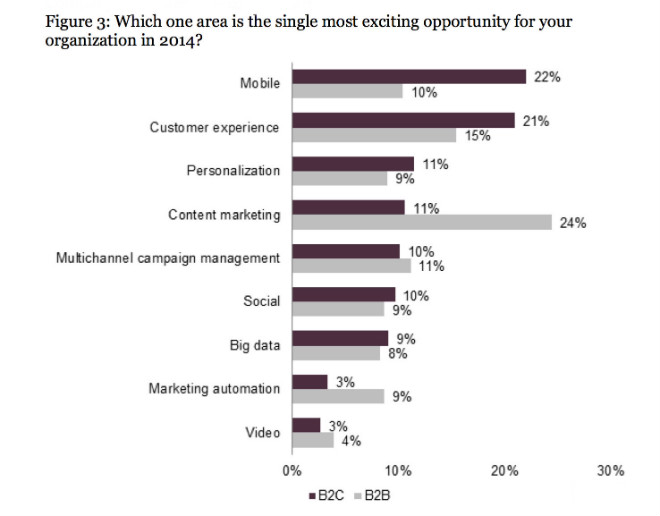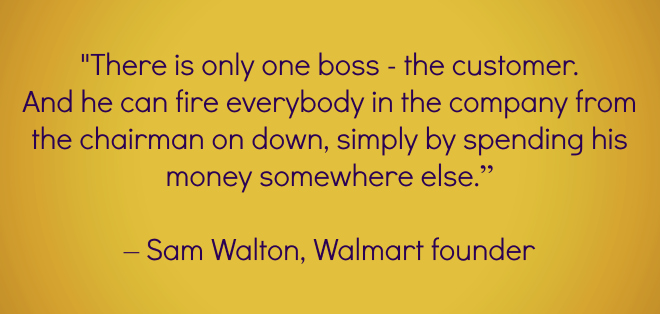The Must-Win Battle for New Customers

Why Perfecting the Customer Experience is a Must-Win Battle in 2014
According to B2B marketers surveyed in Econsultancy’s Quarterly Digital Intelligence Briefing: 2014 Digital Trends, content marketing and customer experience are the two most exciting opportunities for 2014. Here at Digital Marketing NOW, our interest is especially piqued by the relationship between these two opportunities.
For 44% of B2B marketers, content marketing is one of their top three priorities for 2014, and presents the best route for finding new customers and engaging existing ones. Content is an expression of your brand and creates value throughout the customer experience, which in turn creates value for your bottom line. One of the key principles within Econsultancy’s Modern Marketing Manifesto is that “improving the customer experience must be the relentless focus of modern marketing,” and we agree! So the key to your content marketing efforts is not the volume of content you produce, the number of content formats you develop or the number of bylined articles you get published, but instead the impact your content marketing has on the customer experience itself. Tweet this!
A successful customer experience (CX) is undeniably valuable in terms of retaining and growing a robust and loyal customer base. Seventy-three percent of companies agree they can no longer afford to have inconsistent messaging across multiple channels, for risk of disrupting the customer experience. Making the job more challenging, the responsibility to create a seamless, cross-channel experience does not fall on marketing alone. Every customer touch point – events, products, services, hardware, software, customer service, tech support, company website, advertising, email messaging, content management – must be aligned, which requires a company-wide commitment to drive consistently simple, relevant, and pleasurable customer interactions. Remember, at the end of the day, you only have one boss to please: the customer. And so it’s critical to overcome any office politics and internal empire-building in order to make it all about the customer. Tweet this!
Holding many companies back from delivering a truly integrated customer experience, however, is a commonly divided view of whether there needs to be a distinction between traditional marketing and digital marketing. Here at Digital Marketing NOW, we often tell our clients that to the customer, the “marketing channel” does not exist. There is no “offline” or “online”. Customers couldn’t care less whether they are viewing your display ad or billboard. The only thing they see/feel/hear/remember is a customer experience. Period. End of story!
Only 35% of marketers agree that all marketing is digital and believe that talk of “digital marketing” is becoming increasingly redundant (Tweet this!). In contrast, viewing online and offline marketing as separate disciplines keeps marketers from crafting a customer experience that is consistent throughout all touch points. It is surprising that only half of companies surveyed expect that over the next few years using online data to optimize the offline experience will play a “very important” role in their digital marketing (46% believe the reverse: using offline data to optimize the online experience).
To us, these numbers are laughable. Why are the percentages not 100%? Why in the world would you treat the two experiences as distinct and unrelated? Why would you not capitalize on the available data to improve the customer experience regardless of location or marketing vehicle? If a prospective customer is interacting with IBM, Accenture or Salesforce.com, are they really going to say to themselves, “Well, this is an offline marketing vehicle so I really don’t care that their message is contradictory to what I just read online.” Heck no! They are probably going to be confused, lose trust and turn to alternative solutions. Why is this so hard for companies to comprehend?
Within a properly executed CX strategy, online and offline experiences are one in the same. When you eliminate the online/offline aspect, you are left with raw customer data and a single plane for connecting with your audience. Our advice: erase the lines between digital and traditional, and instead define a clear path for bringing the customer experience to life across all channels – via print and display advertising, e-newsletters and customer calls, in-person events and virtual tweet-ups! Tweet this!
Of course, any great customer-driven strategy now features content ready for mobile. How could it not? While the mere fact that your customers want and expect to communicate with you via mobile devices should be reason enough (whatever the customer wants, the customer gets!), newer, faster, better technologies are making it more appealing than ever for marketers to embrace responsive design, location-based services, and geo-targeted advertising to ensure a more seamless CX. Today, 28% of companies report that more than half of their web visits are via mobile devices (60% expect to see 50/50 mobile traffic by 2015), and yet only 17% of B2B marketers list ‘mobile optimization’ as one of their top three digital priorities in 2014. Again, think about the customer, who simply does not acknowledge a difference between online, offline, mobile, tablet, laptop, etc. It is imperative that you deliver experiences without delineation.
So there you have it! In 2014 our major focus is on customer experience and content marketing. Where do your priorities fall? Better yet, what are your customer’s priorities, and how do your priorities align?
All statistics and figures were sourced from the 2014 Digital Trends report by Econsultancy and Adobe. Purchase and read the full report here.


